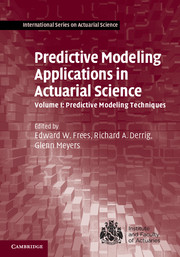Book contents
- Frontmatter
- Contents
- Contributor List
- Acknowledgments
- 1 Predictive Modeling in Actuarial Science
- II Predictive Modeling Foundations
- II Predictive Modeling Methods
- 7 Longitudinal and Panel Data Models
- 8 Linear Mixed Models
- 9 Credibility and Regression Modeling
- 10 Fat-Tailed Regression Models
- 11 Spatial Modeling
- 12 Unsupervised Learning
- III Bayesian and Mixed Modeling
- IV Longitudinal Modeling
- Index
- References
9 - Credibility and Regression Modeling
from II - Predictive Modeling Methods
Published online by Cambridge University Press: 05 August 2014
- Frontmatter
- Contents
- Contributor List
- Acknowledgments
- 1 Predictive Modeling in Actuarial Science
- II Predictive Modeling Foundations
- II Predictive Modeling Methods
- 7 Longitudinal and Panel Data Models
- 8 Linear Mixed Models
- 9 Credibility and Regression Modeling
- 10 Fat-Tailed Regression Models
- 11 Spatial Modeling
- 12 Unsupervised Learning
- III Bayesian and Mixed Modeling
- IV Longitudinal Modeling
- Index
- References
Summary
Chapter Preview. This chapter introduces the reader to credibility and related regression modeling. The first section provides a brief overview of credibility theory and regression-type credibility, and it discusses historical developments. The next section shows how some well-known credibility models can be embedded within the linear mixed model framework. Specific procedures on how such models can be used for prediction and standard ratemaking are given as well. Further, in Section 9.3, a step-by-step numerical example, based on the widely studied Hachemeister's data, is developed to illustrate the methodology. All computations are done using the statistical software package R. The fourth section identifies some practical issues with the standard methodology, in particular, its lack of robustness against various types of outliers. It also discusses possible solutions that have been proposed in the statistical and actuarial literatures. Performance of the most effective proposals is illustrated on the Hachemeister's dataset and compared to that of the standard methods. Suggestions for further reading are made in Section 9.5.
Introduction
9.1.1 Early Developments
Credibility theory is one of the oldest but still most common premium ratemaking techniques in insurance industry. The earliest works in credibility theory date back to the beginning of the 20th century, when Mowbray (1914) and Whitney (1918) laid the foundation for limited fluctuation credibility theory.
- Type
- Chapter
- Information
- Predictive Modeling Applications in Actuarial Science , pp. 217 - 235Publisher: Cambridge University PressPrint publication year: 2014
References
- 2
- Cited by

